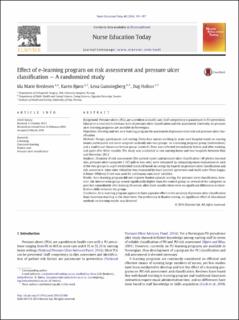| dc.contributor.author | Bredesen, I. M. | |
| dc.contributor.author | Bjøro, K. | |
| dc.contributor.author | Gunningberg, L. | |
| dc.contributor.author | Hofoss, D. | |
| dc.date.accessioned | 2021-05-27T09:54:58Z | |
| dc.date.available | 2021-05-27T09:54:58Z | |
| dc.date.issued | 2016 | |
| dc.identifier.citation | Bredesen, I. M., Bjøro, K., Gunningberg, L. & Hofoss, D. (2016). Effect of e-learning program on risk assessment and pressure ulcer classification - A randomized study. Nurse Education Today, 40, 191–7. | en_US |
| dc.identifier.uri | https://hdl.handle.net/11250/2756582 | |
| dc.description.abstract | Background
Pressure ulcers (PUs) are a problem in health care. Staff competency is paramount to PU prevention. Education is essential to increase skills in pressure ulcer classification and risk assessment. Currently, no pressure ulcer learning programs are available in Norwegian.
Objectives: Develop and test an e-learning program for assessment of pressure ulcer risk and pressure ulcer classification.
Methods
Design, participants and setting: Forty-four nurses working in acute care hospital wards or nursing homes participated and were assigned randomly into two groups: an e-learning program group (intervention) and a traditional classroom lecture group (control). Data was collected immediately before and after training, and again after three months. The study was conducted at one nursing home and two hospitals between May and December 2012.
Analysis: Accuracy of risk assessment (five patient cases) and pressure ulcer classification (40 photos [normal skin, pressure ulcer categories I–IV] split in two sets) were measured by comparing nurse evaluations in each of the two groups to a pre-established standard based on ratings by experts in pressure ulcer classification and risk assessment. Inter-rater reliability was measured by exact percent agreement and multi-rater Fleiss kappa. A Mann–Whitney U test was used for continuous sum score variables.
Results
An e-learning program did not improve Braden subscale scoring. For pressure ulcer classification, however, the intervention group scored significantly higher than the control group on several of the categories in post-test immediately after training. However, after three months there were no significant differences in classification skills between the groups.
Conclusion
An e-learning program appears to have a greater effect on the accuracy of pressure ulcer classification than classroom teaching in the short term. For proficiency in Braden scoring, no significant effect of educational methods on learning results was detected. | en_US |
| dc.publisher | Nurse Education Today | en_US |
| dc.subject | E-learning | en_US |
| dc.subject | classroom learning | en_US |
| dc.subject | Braden scale | en_US |
| dc.subject | pressure ulcer classification | en_US |
| dc.subject | pasientsikkerhet | en_US |
| dc.subject | trykksår | en_US |
| dc.title | Effect of e-learning program on risk assessment and pressure ulcer classification — A randomized study | en_US |
| dc.type | Journal article | en_US |
| dc.source.pagenumber | 191-197 | en_US |
| dc.source.volume | 40 | en_US |
| dc.source.journal | Nurse Education Today | en_US |
| dc.identifier.doi | https://doi.org/10.1016/j.nedt.2016.03.008 | |
| dc.description.localcode | måsjekkes | |
